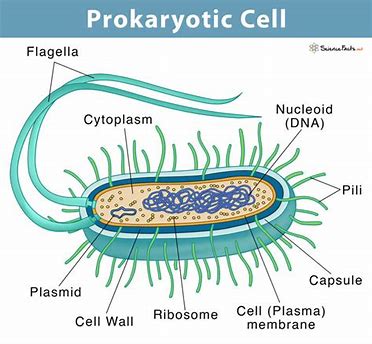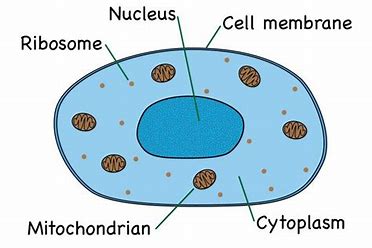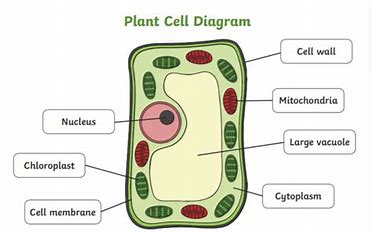Cells are the basic structural and functional units of all living organisms. They are often referred to as the "building blocks of life."
Here are some key points about cells:
1. **Types of Cells**: Cells can be broadly classified into two main types:
- **Prokaryotic Cells**: These cells lack a true nucleus and membrane-bound organelles. Examples include bacteria and archaea.

- **Eukaryotic Cells**: These cells have a true nucleus and membrane-bound organelles. Examples include animal cells, plant cells, fungi, and protists.An animal cell is a type of eukaryotic cell that contains various organelles, each with specific functions.
Here are the main components of an animal cell:
1. **Cell Membrane**: A flexible, semi-permeable barrier that surrounds the cell, controlling the movement of substances in and out of the cell.
2. **Cytoplasm**: A gel-like substance inside the cell that contains the organelles and is the site of various metabolic processes.
3. **Nucleus**: The control center of the cell, containing DNA and responsible for regulating gene expression and cell division.
4. **Nucleolus**: Located within the nucleus, it is involved in the production of ribosomes.
5. **Ribosomes**: Tiny organelles that are the site of protein synthesis, either floating in the cytoplasm or attached to the endoplasmic reticulum.
6. **Endoplasmic Reticulum (ER)**: A network of membranes involved in protein and lipid synthesis. It comes in two forms:
- **Rough ER**: Studded with ribosomes and involved in protein synthesis.
- **Smooth ER**: Lacks ribosomes and is involved in lipid synthesis and detoxification.
7. **Golgi Apparatus**: A stack of membranes that modify, sort, and package proteins and lipids for storage or transport out of the cell.
8. **Mitochondria**: The powerhouse of the cell, responsible for producing energy (ATP) through cellular respiration.
9. **Lysosomes**: Contain digestive enzymes that break down waste materials and cellular debris.
10. **Centrioles**: Involved in cell division, helping to organize the mitotic spindle.
11. **Cytoskeleton**: A network of protein filaments that provide structural support, help maintain the cell's shape, and facilitate movement.
12. **Vesicles**: Small membrane-bound sacs that transport substances within the cell.

A plant cell is a type of eukaryotic cell that has unique structures and functions compared to animal cells. Here are the main components of a plant cell:
1. **Cell Wall**: A rigid outer layer that provides structure, support, and protection. It is primarily composed of cellulose.
2. **Cell Membrane**: A semi-permeable barrier just inside the cell wall that controls the movement of substances in and out of the cell.
3. **Cytoplasm**: The gel-like substance within the cell that contains organelles and is the site of various metabolic processes.
4. **Nucleus**: The control center of the cell that contains DNA and regulates gene expression and cell division.
5. **Nucleolus**: Found within the nucleus, it is involved in the production of ribosomes.
6. **Chloroplasts**: Organelles that contain chlorophyll and are the site of photosynthesis, converting sunlight into chemical energy.
7. **Mitochondria**: The powerhouse of the cell, responsible for producing energy (ATP) through cellular respiration.
8. **Vacuole**: A large, central sac that stores water, nutrients, and waste products. It also helps maintain turgor pressure, keeping the cell rigid.
9. **Endoplasmic Reticulum (ER)**: A network of membranes involved in protein and lipid synthesis. It comes in two forms:
- **Rough ER**: Studded with ribosomes and involved in protein synthesis.
- **Smooth ER**: Lacks ribosomes and is involved in lipid synthesis and detoxification.
10. **Golgi Apparatus**: A stack of membranes that modify, sort, and package proteins and lipids for storage or transport out of the cell.
11. **Ribosomes**: Small organelles that are the site of protein synthesis, either floating in the cytoplasm or attached to the rough ER.
12. **Plasmodesmata**: Channels between plant cell walls that allow for transport and communication between cells.
13. **Peroxisomes**: Organelles that contain enzymes for breaking down fatty acids and detoxifying harmful substances.
14. **Cytoskeleton**: A network of protein filaments that provide structural support, help maintain the cell's shape, and facilitate movement.

2. **Structure of Eukaryotic Cells**: Eukaryotic cells have a complex structure with various organelles, each performing specific functions. Key components include:
- **Nucleus**: Contains the cell's genetic material (DNA) and controls cell activities.
- **Mitochondria**: The powerhouse of the cell, responsible for producing energy (ATP) through cellular respiration.
- **Endoplasmic Reticulum (ER)**: A network of membranes involved in protein and lipid synthesis. It includes rough ER (with ribosomes) and smooth ER (without ribosomes).
- **Golgi Apparatus**: Modifies, sorts, and packages proteins and lipids for transport.
- **Lysosomes**: Contain digestive enzymes that break down waste materials and cellular debris.
- **Ribosomes**: Sites of protein synthesis.
- **Cytoplasm**: A gel-like substance that fills the cell and contains organelles.
- **Cell Membrane**: A semi-permeable barrier that controls the movement of substances in and out of the cell.
- **Cytoskeleton**: A network of protein filaments that provide structural support and facilitate movement.
3. **Functions of Cells**: Cells perform various functions essential for life, including:
- **Metabolism**: Chemical reactions that provide energy and build cellular components.
- **Growth and Reproduction**: Cells grow, divide, and replicate their genetic material.
- **Response to Stimuli**: Cells can sense and respond to changes in their environment.
- **Homeostasis**: Cells maintain a stable internal environment.
4. **Specialized Cells**: In multicellular organisms, cells differentiate into specialized types with distinct functions. Examples include nerve cells, muscle cells, blood cells, and skin cells.
5. **Cell Division**: Cells reproduce through processes such as mitosis (for growth and repair) and meiosis (for sexual reproduction
.png)

.jpeg)





0 Comments: